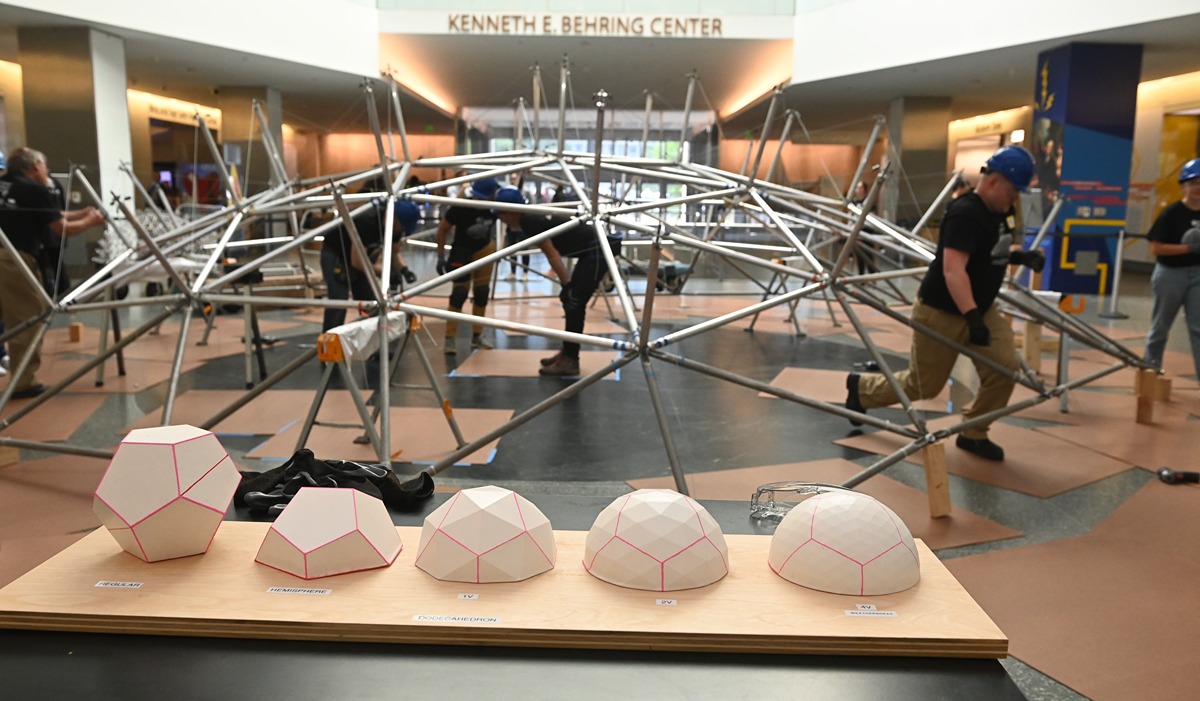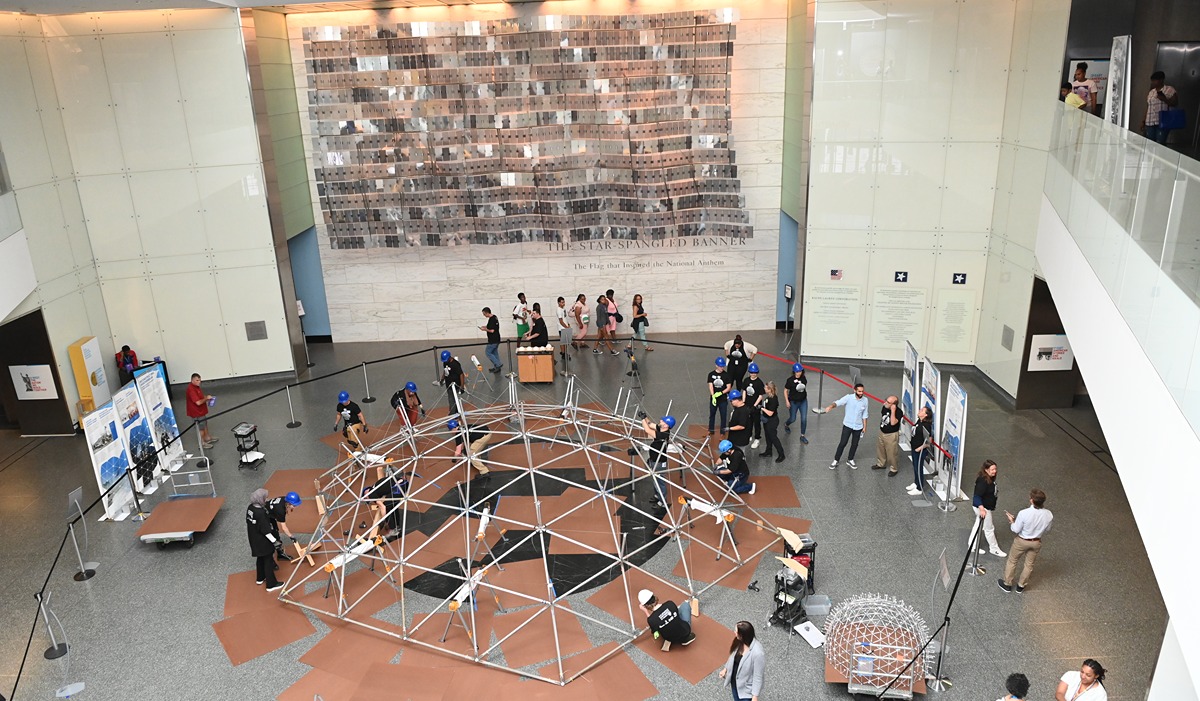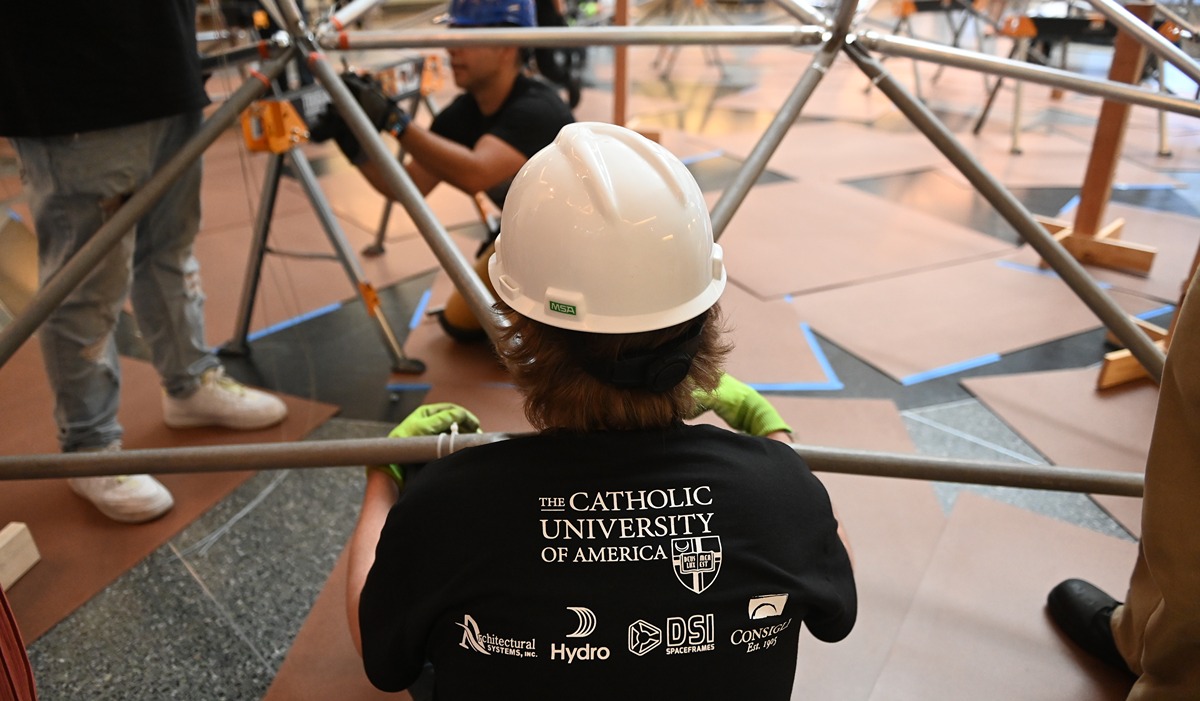

With hurricane season underway, students and faculty from The Catholic University’s School of Architecture and Planning are partnering with the Smithsonian’s National Museum of American History to recreate North America’s first large-span, self-supporting geodesic dome, illustrating the significance of dome architecture in an age of extreme weather. By the nature of their geometry, geodesic domes can support more load and have higher wind resistance than any other shelters of comparable size and weight.
The students, faculty, and museum staff will build the historic dome live as part of the exhibit in the museum’s Flag Hall from July 5 to 7. “Reconstructing ‘Weatherbreak’: Geodesic Domes in an Age of Extreme Weather” will be on view through July 27.
The dome, which is made of almost 1,000 aluminum struts and sprits, did not come with an instruction booklet but only a single page of color-coded strut lengths — which left a mystery for the students enrolled in an architectural history course over the past year, to figure out. An initial surprise was discovering the pieces came in 16 different lengths. Students developed models, worked on the fabrication of missing parts, planned the reconstruction, and undertook two test builds on campus in preparation for the live build.

Inspired by the theories of inventor and futurist Buckminster Fuller, architect Jeffrey Lindsay designed Weatherbreak as a lightweight, stable structure that could resist extreme environmental impacts. This geodesic dome was first built in the winter of 1950 in Montreal and was designed to withstand snow and winds up to 200 miles per hour. It was later reconstructed in the early 1960s in the Hollywood Hills as a mid-century modern home for architect Bernard Judge.
Coined the “Bubble House” by the Los Angeles Times, the dome home was covered with transparent Mylar and shaded by white glass-reinforced neoprene with a silver coating to better reflect the sun. The geodesic dome came to the Smithsonian in the early 1970s. This will be the first time in more than 50 years that the structure is reassembled and the first time it is on exhibit inside the museum.
The public will be able to walk beneath the lattice framework once it is fully assembled. The dome, 25 feet high and 49 feet wide — at 2,000 square feet, nearly the size of the average American home — invites visitors to explore its history and future role in an era of climate change.
“We are proud to partner with the Smithsonian’s National Museum of American History on this groundbreaking project,” said Dr. Peter K. Kilpatrick, President of The Catholic University of America. “This collaboration not only showcases the expertise of our students, but also fosters a critical conversation about the utility of geodesic domes in the face of extreme weather challenges.”

“Weatherbreak was the first large-span geodesic dome built in North America and the first dome home in the world,” said Abeer Saha, Merrill Family Secretarial Scholar and Curator in the museum’s Division of Work and Industry. “Decades later, the nation and planet are focused on sustainability as it relates to climate change. This living exhibition adds to such urgent dialogue by reconstructing and contextualizing the dome for contemporary audiences in an age of extreme weather.”
Visitors will be able to experience one of the most significant architectural innovations of the 20th century and contemplate how history can inform today’s search for sustainable shelters in an era of climate change. Today, millions of people around the world are displaced annually by extreme weather events, and mega-storms such as Hurricanes Katrina (2005), Maria (2017), and Ian (2022) have shown how communities can be severely affected.
Students working on this once-in-a-lifetime, hands-on project are part of an architecture history class under the direction of Tonya Ohnstad, assistant professor of architecture at Catholic University and faculty member Lorenzo Cardim DeAlmeida. These professors previously led the University’s efforts in constructing a full-size replica of a truss from the Cathedral of Notre-Dame de Paris.
Sections of Weatherbreak, including the bottom support rungs and the top of the dome, are being reconstructed using replica parts. The museum will retain some of these replica parts, and Catholic University will have a full set of replica components for future teaching purposes.
The Weatherbreak reconstruction and companion exhibition are made possible with the support and in-kind contributions of faculty and students of Washington University in St. Louis under the leadership of professor Wyly Brown; Architectural Systems Inc., which fabricated missing components; Norsk Hydro, which donated the material for the parts; DSI Spaceframes; and Consigli Construction Co. Inc.